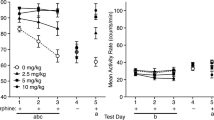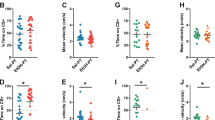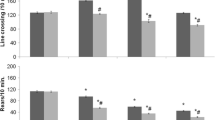Abstract
Rationale
There is evidence to suggest that acetaldehyde is involved in the control of ethanol-seeking behavior and reward. d-penicillamine, a thiol amino acid, is a highly selective agent for the inactivation of acetaldehyde. Previous studies from our laboratory have demonstrated that d-penicillamine prevents both behavioral stimulation induced by ethanol and acetaldehyde-produced locomotor depression in mice.
Objectives
The contribution of ethanol-derived acetaldehyde to the affective effects of ethanol (preference and aversion) was assessed using an unbiased place conditioning design.
Methods
Male mice received four pairings of a distinctive floor stimulus (CS+: GRID+ or HOLE+) with injections of saline and ethanol (2 g/kg) given before (preference) or after (aversion) the 5-min exposure to the place conditioning apparatus. A different floor stimulus (CS−: GRID− or HOLE−), associated with saline-saline injections on alternate days, was presented. For a different group of animals, the pairings with the CS+ were associated with saline and ethanol injections, but on alternate days, they received d-penicillamine (50 or 75 mg/kg) and ethanol injections paired with the CS−floor stimulus. A 60-min preference test was carried out 24 h after the last conditioning trial. A similar procedure was followed to test the effect of d-penicillamine on morphine (16 mg/kg) and cocaine-induced (20 mg/kg) conditioned place preference (CPP).
Results
CPP and conditioned place aversion (CPA) were observed for ethanol, but d-penicillamine only blocked CPP. d-penicillamine, by itself, did not produce either rewarding or aversive effects. CPP observed for morphine and cocaine was unaffected by d-penicillamine pretreatment.
Conclusions
The results of the present study suggest that the selective inactivation of acetaldehyde blocked the rewarding, but not aversive, effects of ethanol and support the role of this ethanol metabolite in the affective properties of ethanol.





Similar content being viewed by others
References
Aragon CMG, Amit Z (1992) The effect of 3-amino-1,2,4-triazole on voluntary ethanol consumption: evidence for brain catalase involvement in the mechanism of action Neuropharmacology 31:709–712
Aragon CMG, Amit Z (1993) Taurine and ethanol-induced conditioned taste aversion. Pharmacol Biochem Behav 44:263–266
Aragon CMG, Spivak K, Amit Z (1985) Blockade of ethanol induced conditioned taste aversion by 3-amino-1,2,4-triazole: evidence for catalase mediated synthesis of acetaldehyde in rat brain. Life Sci 37:2077–2084
Aragon CMG, Stotland LM, Amit Z (1991) Studies on ethanol–brain catalase interaction: evidence for central ethanol oxidation. Alcohol Clin Exp Res 15:165–169
Aragon CMG, Rogan F, Amit Z (1992) Ethanol metabolism in rat brain homogenates by catalase-H202 system. Biochem Pharmacol 44:93–98
Arizzi MN, Correa M, Betz AJ, Wisniecki A, Salamone JD (2003) Behavioral effects of intraventricular injections of low doses of ethanol, acetaldehyde, and acetate in rats: studies with low and high rate operant schedules. Behav Brain Res 147:203–210
Bardo MT, Bevins RA (2000) Conditioned place preference: what does it add to our preclinical understanding of drug reward? Psychopharmacology 153:31–43
Brown ZW, Amit Z, Rockman GE (1979) Intraventricular self-administration of acetaldehyde, but not ethanol, in naive laboratory rats. Psychopharmacology 64:271–276
Brown ZW, Amit Z, Smith B (1980) Intraventricular self-administration of acetaldehyde and voluntary consumption of ethanol in rats. Behav Neural Biol 28:150–155
Cabib S, Puglisi-Allegra S, Genua C, Simon H, Le Moal M, Piazza PV (1996) Dose-dependent aversive and rewarding effects of amphetamine as revealed by a new place conditioning apparatus. Psychopharmacology 125:92–96
Carr GD, Fibiger HC, Phillips AG (1989) Conditioned place preference as a measure of drug reward. In: Liebman JM, Cooper SJ (eds) Neuropharmacological basis of reward. Oxford, New York, pp 264–319
Cederbaum AI, Rubin E (1976) Mechanism of the protective action of cysteine and penicillamine against acetaldehyde-induced mitochondrial injury. Biochem Pharmacol 25:2179–2185
Cohen JF, Elberling JA, DeMaster E, Lin RC, Nagasawa HT (2000) N-Terminal dipeptides of d(-)-penicillamine as sequestration agents for acetaldehyde. J Med Chem 43:1029–1033
Correa M, Miquel M, Sanchis-Segura C, Aragon CMG (1999) Effects of chronic lead administration on ethanol-induced locomotor and brain catalase activity. Alcohol 19:43–49
Correa M, Arizzi MN, Betz A, Mingote S, Salamone JD (2003) Open field locomotor effects in rats after intraventricular injections of ethanol and the ethanol metabolites acetaldehyde and acetate. Brain Res Bull 62:197–202
Coudereau JP, Debray M, Monier C, Bourre JM, Frances H (1997) Isolation impairs place preference conditioning to morphine but not aversive learning in mice. Psychopharmacology 130:117–123
Cunningham CL, Henderson CM (2000) Ethanol-induced conditioned place aversion in mice. Behav Pharmacol 11:591–602
Cunningham CL, Niehus DR, Malott DH, Prather LK (1992) Genetic differences in the rewarding and activating effects of morphine and ethanol. Psychopharmacology 107:385–393
Cunningham CL, Okorn DM, Howard CE (1997) Interstimulus interval determines whether ethanol produces conditioned place preference or aversion. Animal Learn Behav 25:31–42
Cunningham CL, Smith R, McMullin C (2003) Competition between ethanol-induced reward and aversion in place conditioning. Learn Behav 31:273–280
Escarabajal D, Miquel M, Aragon CMG (2000) A psychopharmacological study of the relationship between brain catalase activity and ethanol-induced locomotor activity in mice. J Stud Alcohol 61:493–498
Font L, Miquel M, Aragon CMG (2001) Behavioral consequences of the hypotaurine-ethanol interaction. Pharmacol Biochem Behav 70:333–339
Font L, Miquel M, Correa M, Aragon CMG (2003) Selective inactivation of acetaldehyde by d-penicillamine treatments blocks voluntary ethanol consumption in Long Evans rats. Alcohol and Alcoholism 38:509:P03–P10
Font L, Miquel M, Aragon CMG (2005) Prevention of ethanol-induced behavioral stimulation by d-penicillamine, a sequestration agent for acetaldehyde. Alcohol Clin Exp Res 29:1156–1164
Fudala PJ, Iwamoto ET (1987) Conditioned aversion after delay place conditioning with nicotine. Psychopharmacology 92:376–381
Fudala PJ, Iwamoto ET (1990) Conditioned aversion after delay place conditioning with amphetamine. Pharmacol Biochem Behav 35:89–92
Gill K, Mendez JF, Lucas D, Deitrich RA (1992) Enzymatic production of acetaldehyde from ethanol in rat brain tissue. Alcohol Clin Exp Res 16:910–915
Gill KG, Ryabinin AE, Wang YM, Cunningam CL (2000) c-fos expression induced by ethanol place conditioning in DBA72J mice. Alcohol Clin Exp Res 24:50A
Hoover DJ, Brien JF (1981) Acetaldehyde concentration in rat blood and brain during the calcium carbimide-ethanol interaction. Can J Physiol Pharmacol 59:65–70
Hunt, WA (1996) Role of acetaldehyde in the actions of ethanol in the brain—a review. Alcohol 13:147–151
Itzhak Y, Martin JL, Black MD, Huang PL (1998) The role of neuronal nitric oxide synthase in cocaine-induced conditioned place preference. Neuroreport 9:2485–2488
Kera Y, Kiriyama T, Komura S (1985) Conjugation of acetaldehyde with cysteinglycine, the first metabolite in glutathione breakdown by γ-glutamyltranspetidase. Agents Actions 17:48–52
Koechling UM, Amit Z (1994) Effects of 3-amino-1,2,4-triazole on brain catalase in the mediation of ethanol consumption in mice. Alcohol 11:235–239
Manrique HM, Miquel M, Aragon CMG (2005) Brain catalase mediates potentiation of social recognition memory produced by ethanol in mice. Drug Alcohol Depend 79:343–350
Manzanedo C, Aguilar MA, Rodríguez-Arias M, Navarro M, Miñarro J (2004) 7-Nitroindazole blocks conditioned place preference but not hyperactivity induced by morphine. Behav Brain Res 150:73–82
Masur J, Boerngen R (1980) The excitatory component of ethanol in mice: a chronic study. Pharmacol Biochem Behav 13:777–780
Miquel M, Font L, Sanchis-Segura C, Aragon CMG (2003) Neonatal administration of monosodium glutamate prevents the development of ethanol- but not psychostimulant-induced sensitization: a putative role of the arcuate nucleus. Eur J Neurosci 17:2163–2170
Mucha RF, Iversen SD (1984) Reinforcing properties of morphine and naloxone revealed by conditioned place preferences: a procedural examination. Psychopharmacology 82:241–247
Nagasawa HT, Goon DJ, Constantino NV, Alexander CS (1975) Diversion of ethanol metabolism by sulfhydryl amino acids. d-penicillamine-directed excretion of 2,5,5-trimethyl-D-thiazolidine-4-carboxylic acid in the urine of rats after ethanol administration. Life Sci 17:707–713
Nagasawa HT, Goon DJ, DeMaster EG (1978) 2,5,5-Trimethylthiazolidine-4-carboxylic acid, a d(-)-penicillamine-directed pseudometabolite of ethanol. Detoxication mechanism for acetaldehyde. J Med Chem 21:1274–1279
Nagasawa HT, Elberling JA, Roberts J (1987) β-substituted cysteines as sequestering agents for ethanol-derived acetaldehyde in vivo. J Med Chem 30:1373–1378
Pastor R, Sanchis-Segura C, Aragon CMG (2002) Ethanol-stimulated behaviour in mice is modulated by brain catalase activity and H2O2 rate of production. Psychopharmacology 165:51–59
Phillips TJ, Dickinson S, Burkhart-Kasch S (1994) Behavioral sensitization to drug stimulant effects in C57BL/6J and DBA/2J inbred mice. Behav Neurosci 108:789–803
Pohorecky LA (1977) Biphasic action of ethanol. Biobehav Rev 1:231–240
Quertemont E, De Witte P (2001) Conditioned stimulus preference after acetaldehyde but not ethanol injections. Pharmacol Biochem Behav 68:449–454
Quertemont E, Tambour S, Bernaerts P, Zimatkin SM, Tirelli E (2004) Behavioral characterization of acetaldehyde in C57BL/6J mice: locomotor, hypnotic, anxiolytic and amnesic effects. Psychopharmacology 177:84–92
Quertemont E, Grant KA, Correa M, Arizzi MN, Salamone JD, Tambour S, Aragon CMG, McBride WJ, Rodd ZA, Goldstein A, Zaffaroni A, Li TK, Pisano M, Diana M (2005) The role of acetaldehyde in the central effects of ethanol. Alcohol Clin Exp Res 29:221–234
Risinger FO, Oakes RA (1996) Dose- and conditioning trial-dependent ethanol-induced conditioned place preference in Swiss-Webster mice. Pharmacol Biochem Behav 55:117–123
Risinger FO, Malott DH, Prather LK, Niehus DR, Cunningham CL (1994) Motivational properties of ethanol in mice selectively bred for ethanol-induced locomotor differences. Psychopharmacology 116:207–216
Rodd-Henricks ZA, McKinzie DL, Crile RS, Murphy JM, McBride WJ (2000) Regional heterogeneity for the intracranial self-administration of ethanol within the ventral tegmental area of female Wistar rats. Psychopharmacology 149:217–224
Rodd-Henricks ZA, Melendez RI, Zaffaroni A, Goldstein A, McBride WJ, Li TK (2002) The reinforcing effects of acetaldehyde in the posterior ventral tegmental area of alcohol-preferring rats. Pharmacol Biochem Behav 72:55–64
Rodd-Henricks ZA, Bell RL, Zhang Y, Murphy JM, Goldstein A, Zaffaroni A, Li TK, McBride WJ (2005) Regional heterogeneity for the intracranial self-administration of ethanol and acetaldehyde within the ventral tegmental area of Alcohol-Prefering (P) rats: Involvement of dopamine and serotonine. Neuropsychopharmacology 30:303–308
Sanchis-Segura C, Miquel M, Correa M, Aragon CMG (1999a) The catalase inhibitor sodium azide reduces ethanol-induced locomotor activity. Alcohol 19:37–42
Sanchis-Segura C, Miquel M, Correa M, Aragon CMG (1999b) Cyanamide reduces brain catalase and ethanol-induced locomotor activity: is there a functional link? Psychopharmacology 144:83–89
Sippel HW (1974) The acetaldehyde content in rat brain during ethanol metabolism. J Neurochem 23:451–452
Smith BR, Amit Z, Splawinsky J (1984) Conditioned place preference induced by intraventricular infusions of acetaldehyde. Alcohol 1:193–195
Smith BR, Aragon CMG, Amit Z (1997) Catalase and the production of central acetaldehyde: a possible mediator of the psychopharmacological effects of ethanol. Addict Biol 2:227–289
Tabakoff B, Anderson RA, Ritzmann RF (1976) Brain acetaldehyde after ethanol administration. Biochem Pharmacol 1:1305–1309
Tampier L, Quintanilla ME (2003) Involvement of brain ethanol metabolism on acute tolerance development and on ethanol consumption in alcohol-drinker (UChB) and non-drinker (UChA) rats. Addict Biol 8:279–286
Tanimoto H, Heinsenberg M, Gerber B (2004) Event timing turns punishment to reward. Nature 430:983
Tzschentke TM (1998) Measuring reward with the conditioned place preference paradigm: a comprehensive review of drug effects, recent progress and new issues. Prog Neurobiol 56:613–672
Van der Kooy D (1987) Place conditioning: a simple and effective method for assessing the motivational properties of drugs. In: Bozarth MA (ed) Methods of assessing the reinforcing properties of abused drugs. Springer Verlag, Berlin Heidelberg New York, pp 229–240
Ward RJ, Colantuoni C, Dahchour A, Quertemont E, De Witte P (1997) Acetaldehyde-induced changes in the monoamine and amino acid extracellular microdialysate content of the nucleus accumbens. Neuropharmacology, 36:225–232
Wigley FM, Sule SD (2001) Novel therapy in the treatment of scleroderma. Expert Opin Investig Drugs 10:31–48
Wise RA (1989) The brain and reward. In: Laibman JM, Cooper SJ (eds) The neuropharmacological basis of reward. Clarendon Press, Oxford, pp 377–424
Yusof M, Neal R, Aykin N, Ercal N (2000) High performance liquid chromatography analysis of d-penicillamine by derivatization with N-(1-pyrenyl)maleimide (NPM). Biomed Chromatogr 14:535–540
Acknowledgements
This study was supported by grants from Generalitat Valenciana (05I151.01/2) and from Red de Trastornos Adictivos, Ministerio de Sanidad y Consumo (G03/005), Spain. The authors gratefully acknowledge the technical assistance provided by Alicia Dosda and Gemma Caballer and the linguistic revision by Fiona McClelland. Animal procedures were performed in accordance with the European Community Council directive (86/609/ECC).
Author information
Authors and Affiliations
Corresponding author
Rights and permissions
About this article
Cite this article
Font, L., Aragon, C.M.G. & Miquel, M. Ethanol-induced conditioned place preference, but not aversion, is blocked by treatment with d-penicillamine, an inactivation agent for acetaldehyde. Psychopharmacology 184, 56–64 (2006). https://doi.org/10.1007/s00213-005-0224-z
Received:
Accepted:
Published:
Issue Date:
DOI: https://doi.org/10.1007/s00213-005-0224-z




